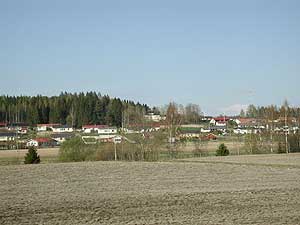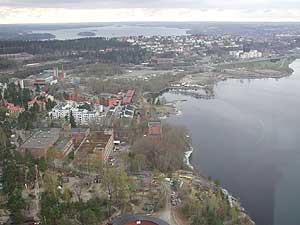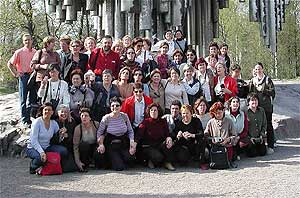" Has ¿Te given bill that in the gardens of the finland schools that we have visited there were few trees?" A teacher commented it in the one on the way to return and you could see in her look the satisfaction of being making a reading of the reality that you grieve you had just visited, a reading that at the same time began the understanding and the interpretation of a context so different to ours.
The gardens of big dimensions, thought and designed so that the children and girls could find different possibilities of games, of discovered and hiding places, as he/she made us observe the teacher they had few trees and all, of leaf expire, possibly to pick up all the sun and the light that, in that country, they are scarce during too much time.
Soon after a small group of teachers wondered why in the different centers that we had visited in the cities of Tampere and Helsinki there was so few toilets. And with the comment a new conversation began on what had been seen, and observations were chained this way, reflections, comparisons, ideas, and new queries opened up beginning to build a group idea.
Three toilets and a single table to change are an equipment more than enough for the heterogeneous groups of age, in the measure that this daily activity the children and parvulario girls carry out it when they have necessity, and they have the possibility to choose their favorite cup, like in the story of ripples of gold: there is the small one, the big one with a small hole, the big one with a stool to arrive, all the cups of wáter with separadores and doors. Maybe to respect the intimacy? Maybe so that the children and can girls choose in such a personal question? Maybe to be able to decide in a seemingly so not very transcendent question, but that it facilitates them to decide many times a day? Maybe the fact of being considered and respected in questions so elementary, so daily, it can favor in the children and girls the competition feeling, of self-esteem. Maybe such a simple question can contribute to the fact that the country is competitive.
That of this year is the 21º study trip that is organized from Childhood and the third visited Scandinavian country has been, in which the opportunity has been had of knowing directly with a collective reading that always allows to go further on, in the measure that, on what we are seeing, listening, playing, feeling and thinking, that is inserted that they think and they tell the other envelope that reality.
It is a process poliédrico of a wealth and a shade difficult to explain in the measure that contains a great diversity of personal, historical and territorial shades, of which each one is payee, from Castile-the Stain to the Basque Country, going by Madrid, Menorca, Granada and Catalonia, with a wide representation of the west lands, of l'Empordà, the Maresme, Barcelona, the Baix Llobregat and the Vallès, the Field of Tarragona and the Penedès.
Finland, the earth of the sami, is today a modern country, with a high technological level that he/she appears continuously in the media like one of the most competitive countries in the world. During our visit, we could meet a country that he/she thinks and it acts toward their citizens, a modest, kind, serene country. With placidness in the landscape, in the treatment, in the way of conceiving the centers for the children and girls, so much in their structure and organization, like in their architecture and their pedagogy.
As in the other Scandinavian countries, the centers for the children and girls of 0 to 7 years Finnish are competition of the city councils, always accompanied by the corresponding budgets, budgets that he/she knows everybody.
So much in Tampere as Helsinki, the centers that we visit had some common parameters that allowed us to identify the harmony and the coherence of that reality:
The ages that welcomed: The children and smaller girls had between 8 and 10 months and the adults 7 years, age in which the obligatory school begins.
The organization of the groups: They were heterogeneous. Those of the small ones belonged to 12 children and girls between 8 months and 3 years; those of the adults, of 21 children and girls between 3 and 7 years, and each group had 3 educators.
The number of children and girls for educator: Each educator has 4 of the group of the small ones and 7 of that of the adults.
The rules horarias:
Most of the children and girls were between 6 and 9 h. The educators, all them 7 daily h worked with children and 1 daily h dedicated to make work meetings. Of the centers, 90% had open from 6 o'clock to the 18 h.
There is a small percentage of centers that you/they welcomed the one that you/they are the less common necessities. It is the case, for example, of the centers outdoors, some parks in those which, informally, parents or other relatives that are careful the children and girls smaller than seven years go to play some whiles a day.
There, those more bigger than seven years, after the school schedule and in periods of vacations, also go to play without a relative's company.
As exponent of the other end of the offer there are also some centers that 24 h opens up. They assist the necessities of families with schedules of work of long shifts, as those that have to navigate. The organization of these centers in Helsinki was very flexible to facilitate to the families that could be with the children and girls when they didn't work.
We knew, also, some centers that welcome the children and girls from 2 to 7 years non escolarizados 4 hours a week.
The offer and the demand:
The families that you/they want a school square are assisted the demand in few weeks. The percentage of children and girls escolarizados in both cities are located around 65%. A percentage that varies according to the age of the children and girls: in those of 6 to 7 years is located in 94%; in those of 3 to 6 years, in 81% and in the smallest in 3 years, in 20%.
The cost and the quota:
For the children and girls of 6 to 7 years is an offer of four daily hours of gratuitous school, of which participates 94% of the children and girls of these ages. The cost of a boy up to 7 years in the centers Finnish are of 7.500 Eurus to in the year and the quota that you/they pay the families it is from 200 Eurus to month.
The spaces and the equipment:
Even when each center of those that we visit was different, as visitors we could feel that there was a common atmosphere, maybe the curtains, or the colors of the sofas, or the tables of different measures that made evident a welcoming atmosphere. The receiver with all the tackle to clean the shoes and to dry the clothes showed the pragmatism, the functionality and at the same time the way to live the inside of and the one was as an everything. Besides the spaces of life of each group where eaten, to sleep and, mainly, to play, in the centers spaces could be seen for concrete activities: kitchens to the height of the children -but really -, carpentry shops, spaces thought to play with water and, in some, a spaces where we could not consent the adults.
The teachers of Tampere told us to feel inheritors of Dewey, Macarenko, Pestalozzi, Vigotsky, and that now they were identified with Malaguzzi. To Helsinki they spoke to each other of Montessori, Pestalozzi and Hoslainer. To the question they thought of what that it could define their current pedagogy, what you/they told us and what we saw was coherent: the small groups, to be able to listen the one that the children and girls say, to be able to discover the thought, like they learn the some of the other ones and, therefore, the groups with children of different ages.
We could see as the theater, the plastic art, the sports and the music were important in the life of the centers, where the pianos (of those which, in most of the centers, there were two) they shared physical spaces and storms with the computers, and some and other perfectly equipped and used. We saw as the tradition and the innovation they were knitted in a current and alive reality, in the one which the children and girls and the adults felt comfortable.
Until here the parameters that allowed us to understand their way to guarantee the quality, but, as well as we have been able to observe in other countries, the autonomy of each center, thing that allows to discover that of matter and personal that can be in each one of them. A personality that facilitates the personalización, the difference, the qualitative appropriation of a collective space of all and not of anybody, that in which you can find the old plant that it has grown to the school for years and that every year it flourishes, or the small cutting of newspaper of the day before hooked in a plafón that causes the conversation when the coffee.
One of the centers that visit was new of triplet. The children and girls waited for us in the porch singing a song. It was located in a new neighborhood and in full growth. Many streets were still to asphalt and the houses of about the school had just been inhabited hardly. The school, amid the neighborhood, already gave him life.
In this trip we went preparations for the cold, but we pass heat. The long and hot days they allowed to feel like he/she woke up the spring. The gray of the fine branches of the birches, the tree of their craft and their design, day after day, it changed the yellow to the green.
After all it has contributed, in some aspects, to break outlines. In other, he/she has given security and it has outlined new queries. It is necessary to speak, to compare, to discuss, to build, to imagine again.

|

|

|

|

|

|

|

|

|

|